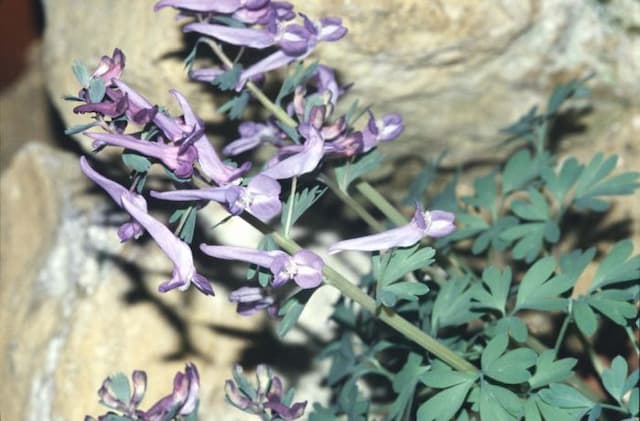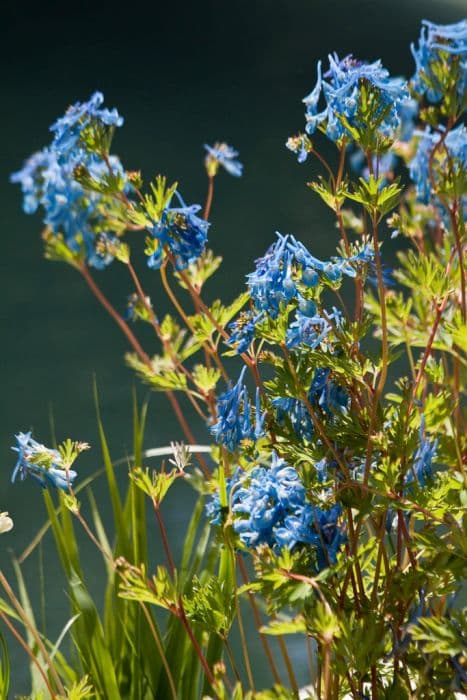Craigton Blue Corydalis Corydalis 'Craigton Blue'

ABOUT
Corydalis 'Craigton Blue' is a charming perennial plant with a delicate appearance that makes it a favorite in garden borders and rockeries. This plant features a lush mound of finely divided, fern-like foliage that provides an attractive backdrop for its blooms. The leaves are a soft green, creating a perfect contrast to the beautiful flowers. The standout feature of 'Craigton Blue' is its abundant, tubular flowers that carry a striking shade of blue. These blossoms are arranged in graceful racemes that rise above the foliage on slender stems, giving the plant a light and airy look. The flowers have a slightly nodding habit, which adds to their delicate charm. This plant tends to bloom in the springtime, producing a profusion of these blue flowers that can add a cool and soothing tone to any garden space. When in full bloom, 'Craigton Blue' presents a picturesque display that can attract pollinators such as bees and butterflies. Overall, the appearance of Corydalis 'Craigton Blue' is characterized by its lacy green leaves and captivating blue flowers, combined to create a soft, romantic effect in the garden. The plant’s aesthetic makes it a perfect choice for gardeners looking to add a touch of serene beauty to their outdoor spaces.
About this plant
 Names
NamesFamily
Papaveraceae
Synonyms
Fumewort
Common names
Corydalis 'Craigton Blue'.
 Toxicity
ToxicityTo humans
Corydalis 'Craigton Blue' is generally considered to have low toxicity to humans. However, it may contain alkaloids that could theoretically cause mild stomach upset if ingested in large quantities. Symptoms of ingesting significant amounts of the plant might include nausea, vomiting, or diarrhea. It's advisable to avoid consuming this plant, as with many ornamental plants, to prevent any potential adverse effects.
To pets
Corydalis 'Craigton Blue', like for humans, is generally regarded as having low toxicity to pets. However, if ingested in substantial amounts, the alkaloids present in the plant could cause mild gastrointestinal disturbances such as nausea, vomiting, and diarrhea in pets. Care should be taken to prevent pets from consuming the plant to avoid these possible symptoms.
 Characteristics
CharacteristicsLife cycle
Perennials
Foliage type
Deciduous
Color of leaves
Green
Flower color
Blue
Height
1 foot 3 inches [40 cm]
Spread
1 foot [30 cm]
Plant type
Herb
Hardiness zones
5
Native area
Europe
Benefits
 General Benefits
General Benefits- Aesthetic Appeal: Corydalis 'Craigton Blue', also known as Fumewort, adds a touch of blue to the garden with its delicate, tubular flowers that bloom in the spring.
- Attracts Pollinators: The vibrant flowers can attract beneficial pollinators like bees and butterflies, which are essential for a healthy ecosystem.
- Spring Bloom: Fumewort provides early-season blooms, offering visual interest in the garden when many other plants are just beginning to emerge.
- Shade Tolerance: This plant is well-suited for shaded areas, making it a good choice for woodland gardens or parts of the landscape that receive limited sunlight.
- Deer and Rabbit Resistant: Fumewort is generally not preferred by deer and rabbits, which can help to reduce plant damage in the garden.
- Low Maintenance: Once established, Corydalis is relatively low maintenance, requiring minimal care beyond regular watering and occasional feeding.
- Extended Flowering Period: With the right care and conditions, Fumewort has the potential for a long flowering season, extending the visual enjoyment of its blooms.
- Naturalizing: Corydalis 'Craigton Blue' can naturalize in the garden, filling in spaces and potentially spreading to create larger drifts of color.
 Medical Properties
Medical PropertiesThis plant is not used for medical purposes.
 Air-purifying Qualities
Air-purifying QualitiesThis plant is not specifically known for air purifying qualities.
 Other Uses
Other Uses- Corydalis 'Craigton Blue' can be used as a natural dye source; the plant's roots and flowers may yield subtle color variations for fabrics and yarns.
- The plant might be included in a sensory garden due to its delicate and attractive flowers, which can provide visual interest and inspiration for artists and photographers.
- As a groundcover, Corydalis 'Craigton Blue' can be very effective in shady garden areas where it can form a lush carpet under trees and shrubs.
- The flowers of the plant can be used in floral arrangements to provide a soft, blue accent that complements other flowers.
- When planted in mass, the Corydalis 'Craigton Blue' can be used to stabilize soil on slopes and prevent erosion.
- Gardeners may use the plant as a living mulch to help retain soil moisture and suppress weeds due to its dense foliage.
- In frost-free climates, Corydalis 'Craigton Blue' can be used as a perennial bedding plant, providing year-round interest.
- This plant can serve as a habitat for beneficial insects, including bees and butterflies, thus promoting biodiversity in the garden.
- Corydalis 'Craigton Blue' can be used for educational purposes in schools or community gardens to teach about plant growth and propagation.
- Finally, the plant can play a role in companion planting, potentially deterring certain pests due to its unique chemical composition.
Interesting Facts
 Feng Shui
Feng ShuiThe Corydalis plant is not used in Feng Shui practice.
 Zodiac Sign Compitability
Zodiac Sign CompitabilityThe Corydalis plant is not used in astrology practice.
 Plant Symbolism
Plant Symbolism- Tranquility: Corydalis 'Craigton Blue', like many plants with soft blue flowers, is often associated with a sense of calm and peace, signifying the tranquility of nature.
- Fleeting Nature: The ephemeral blooms of the Corydalis, which may close up in intense sunlight, can symbolize life's fleeting nature and the preciousness of each moment.
- Joy: The bright blue flowers can also represent joy and happiness, bringing a cheerful presence to the garden or landscape where they grow.
- Adaptation: Corydalis is known for its ability to grow in difficult conditions, often symbolizing adaptability and perseverance in the face of challenges.
 Water
WaterFumewort needs to be watered regularly but with caution to prevent waterlogging as it prefers well-drained soil. During active growth in the spring and early summer, watering might be necessary once or twice a week, providing about a gallon per plant each time, depending on the weather conditions and soil moisture. Allow the top inch of soil to dry out between waterings. Reduce frequency as the plant goes dormant in late summer, as overwatering during this period can harm the plant. Always water at the base of the plant to avoid wetting the foliage which can lead to fungal diseases.
 Light
LightFumewort thrives in partial shade to full shade conditions. It prefers to be sheltered from the intense midday sun, making it ideal for planting under deciduous trees or on the north or east side of buildings where it will receive morning or late afternoon light. Avoiding exposure to harsh sunlight will help maintain the vibrancy of its blue flowers and prevent scorching of its delicate foliage.
 Temperature
TemperatureFumewort prefers cooler temperatures and does well in a temperature range between 50°F and 70°F, which corresponds to spring and fall weather in many temperate regions. It can survive minimum temperatures down to about 20°F, but growth will be considerably slowed down. Protecting this plant from extreme heat is important, as temperatures over 75°F can stress the plant, particularly if it is exposed to direct sunlight.
 Pruning
PruningPruning fumewort is generally done to tidy the plant and remove spent flowers to encourage further blooming. After the initial flowering in spring, cut back the flower stems by half to stimulate a second flush of blooms. Prune again in late fall to remove dead foliage and help prevent fungal diseases. The best time for major pruning is late winter or early spring before new growth begins.
 Cleaning
CleaningAs needed
 Soil
SoilFumewort (Corydalis 'Craigton Blue') thrives in a well-draining soil mix rich in organic matter, with a pH ranging from slightly acidic to neutral (pH 6.0 to 7.0). A mixture containing loamy garden soil, compost, and a small amount of perlite or grit to aid drainage would be ideal for this plant.
 Repotting
RepottingFumewort should typically be repotted every 2-3 years or when it has outgrown its current container. It’s best to repot in early spring before the growing season begins.
 Humidity & Misting
Humidity & MistingCorydalis 'Craigton Blue', commonly known as Fumewort, prefers moderate to high humidity levels, but it is adaptable and can tolerate a range of humidity conditions common in most homes.
 Suitable locations
Suitable locationsIndoor
Place in bright, indirect light with well-draining soil.
Outdoor
Partial shade, sheltered location, well-draining soil, mulch to retain moisture.
Hardiness zone
5-7 USDA
 Life cycle
Life cycleCorydalis 'Craigton Blue', commonly known as Craigton Blue Corydalis, begins its life cycle when seeds germinate in cool, moist conditions, often in early spring. Once the seedlings establish, they develop into clumps of finely divided, fern-like foliage. From late spring to early summer, the plant produces clusters of intense blue, tubular flowers that attract pollinators. After flowering, the plant sets seed, which may self-sow in conducive garden conditions, continuing its life cycle. In mid to late summer, the plant often goes dormant, with foliage dying back especially if conditions are too dry or hot. It overwinters as a tuber or root system, re-emerging the following spring to repeat its growth cycle.
 Propogation
PropogationPropogation time
Spring to Early Summer
Propogation: Corydalis 'Craigton Blue', commonly known as Fumewort, is typically propagated through division, which is best carried out in the autumn, just after the plant has finished flowering and when the foliage has died back. To propagate by division, carefully lift the plant from the soil using a fork, ensuring minimal root disturbance. Gently tease apart the tubers, ensuring that each division has at least one growth point. Replant the divisions immediately, at the same depth they were growing before, spacing them about 8 inches (approximately 20 centimeters) apart to allow enough room for growth. Water the newly planted divisions thoroughly to help establish roots in their new location. This method of propagation is quite effective for Corydalis 'Craigton Blue' and helps to maintain the vigor of the plant while increasing your stock.









